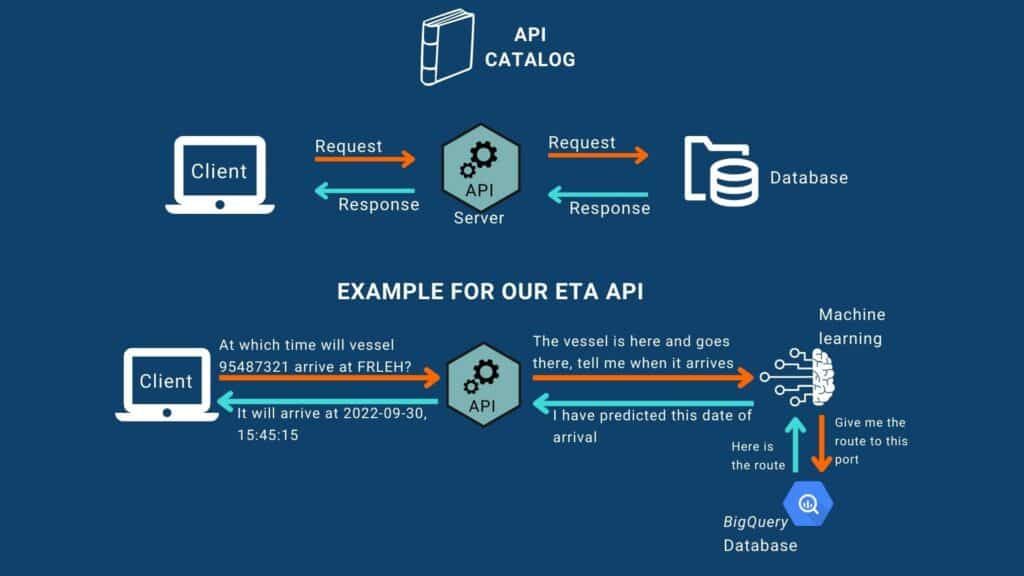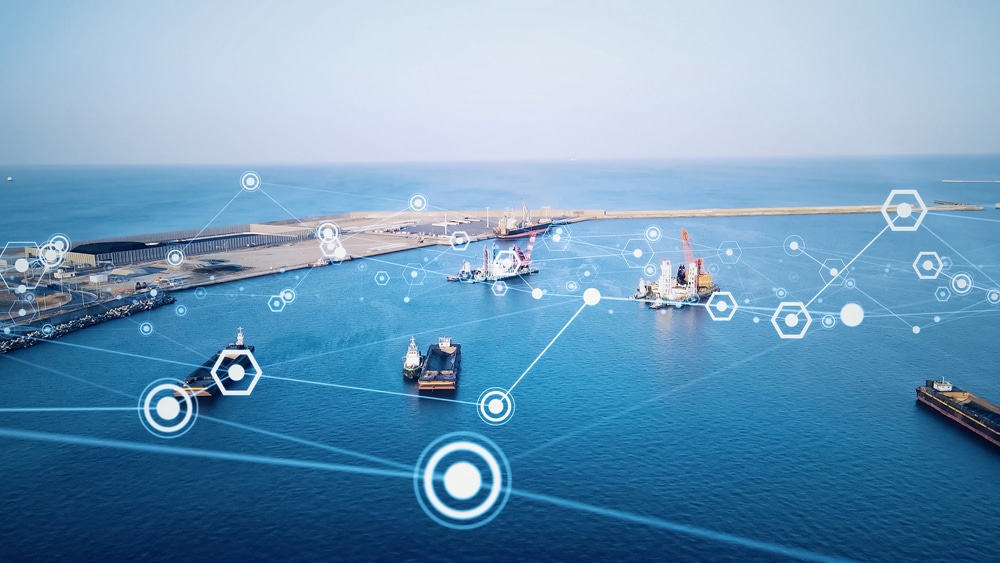API stands for an application programming interface. They are needed to enable two or more computer programs to interact, using very simple commands. Thanks to this interface, developers can build new interactions between applications, whether they are internationally popular or have been created for a specific trade, sector, or company. This article provides insight into the benefits of APIs and the way they can help ports, but also the challenges that arise from their integration.
What are the main benefits of using API?
All types of software can use APIs for various purposes requiring a two-way data transfer (e-commerce transaction, logging on to a website without having to register, sending money to a bank account, etc.). Thanks to APIs, a company’s internal applications and services become accessible via the Internet to the public or restricted to strategic partners (customers, suppliers, business partners, and other third parties).
How to Track a Ship In Real-Time ?
Let us look at how a ships’ real-time tracker works, its details and features, its benefits for all players in the shipping sector but also its weaknesses…
How does an API work?
When developers create programs, they don’t have to re-write the code from A to Z. Instead, they use pre-existing infrastructure to integrate (“plug”) their new applications into existing software while minimizing costs and time. To do so, they rely on REST API (Representational State Transfer Application Program Interface), which acts as a link between two computer systems, allowing a secure exchange of information smoothly and continuously, using HTTP protocols. There are three main categories of APIs: REST, SOAP, and RPC. Most of the time we will talk about the REST format, which is the best-known and most popular approach.
In simple words, when the user clicks on an application feature, the API is the essential node that transmits the request to the service provider’s server, which makes whatever is necessary. Then the outcome is sent back to the application via the API and consequently shown to the user in an understandable format. An API can work with two programs from the same internal network or over the Internet.
How are APIs used in our daily life and business?
People over the world use APIs daily, but most of the time, without being aware of it. For example, login in or registering on a website can be done using Facebook, Google, or Apple accounts. This functionality is made possible by an API that authenticates the user’s identity, and it doesn’t even actually log him into social media.
PayPal makes another great example of a common application using API. When paying a purchase on an online store, this latter does not access the customer’s sensitive data, but only the minimum information required to complete the transaction.
The same applies to price comparison websites for services such as flight tickets, accommodation, cheap vacations, etc. Third-party APIs gather information from the concerned companies (airlines, travel agents, hotels, etc.), allowing the site to aggregate multiple options and display the ones that meet the user’s expectations.
Google also provides Cloud APIs, which are programmatic interfaces to its platform services like Google Maps. They allow companies to easily add the potential of machine-learning-based data analysis to their applications. To try Google API without writing code, one can use Google APIs Explorer, which is accessible on most REST API reference documentation pages.

How do APIs help business?
APIs help business improve their efficiency, productivity, and attractiveness in different aspects. Here are some of the benefits that can be obtained from using this technology:
- Ease integration
An API allows interrelationships between very different platforms, applications, and systems, with less effort and by saving resources (human, material, and financial) and time.
- Automate tasks
API integration enables real-time data exchange across all channels and automation of a wide range of tasks. Automation avoids manual tasks, and to a certain extent human errors, during the transition between linked applications.
- Extend the offering
By using APIs, companies simplify the integration of their new applications or digital products into existing infrastructure or complete their own offer/system with third-party services. A more comprehensive value proposition becomes more attractive to customers.
- Drive innovation
APIs empower developers to launch innovative solutions or business models faster and better without spending a lot of time and money. They can assemble software components in a program or interface with other programs simply by reusing code instead of starting from scratch. This contributes to making the company more agile and to accelerate its digital transformation.
How do APIs help ports?
Ports are the perfect example of an ecosystem that needs APIs to connect the systems of all public and private entities with whom they share data:
- local, national, and other countries’ authorities;
- shipping companies and agencies;
- ships’ crew;
- freight forwarders;
- trucking, railway, and barge transportation companies;
- warehouse managers;
- shippers;
- cargo owners;
- and all other players in the ocean freight industry.
Sinay’s IA-based solutions can work smoothly with all those stakeholders’ applications and adapt to the business’s specific needs. API is provided for quick and seamless integration into the company’s system. Thus, Sinay’s customers improve their own platform’s functionality and usability.
For example, using its ETA calculator module is very easy for end-users, providing them with an improved customer experience. For port authorities and terminal managers, this powerful tool helps to streamline processes and operations. Based on an accurate prediction of each ship’s ETA, teams are able to optimize resource allocation and port calls. Not only can good preparation avoid conflicts at berth and maximize safety, but it also contributes to preventing port congestion, which has become a significant issue these past years.
To better understand, in the ETA Calculator, the client provides a vessel identifier and a destination, and the API can predict a time of arrival. But many invisible things happen in the API backroom: it asks for the last position of the vessel and its particulars to the database and then provides the information to a machine learning system. The system will find the most appropriate route from the ones stored in a database, do its magic, and give the predicted time of arrival back to the API. Finally, the response is served to the client, which can be Sinay’s own ETA Calculator module or a developer who integrated it into a Port Traffic Management System (PTMS).
A port congestion API is also available to increase operational efficiency and cut costs. To add the real-time congestion status of a port in its usual tools is fast and easy.

What are the most common challenges of using APIs?
Despite the multiple conveniences and advantages of APIs, their integration process comes with some obstacles. Fortunately, there are effective ways to overcome these barriers.
- Security
The main challenge of using such technology is related to cybersecurity since it is reliant on web-based programs. When the integration is not properly done, and not carefully protected, an API may open breaches that threaten the entire Information System (IS).
Indeed, as a single point of entry, an API is a gateway and can become a hacker’s primary target. Once the API is compromised, all other applications and systems become vulnerable. In case of an attack, the company may lose sensitive data or have its IS locked. The commercial, financial, and reputational damages are potentially huge.
Furthermore, data losses may also affect the users of an application if their personal information has been exposed.
- Technological complexity
Adopting an API may lead to incompatibility among several systems that will connect to it simultaneously, or to misunderstandings about responsibilities among all internal departments concerned with its integration. This is because system integration is not one-size-fits-all. Hence some systems might take more time than others to be developed and fully operational.
Business cases are mandatory for each department affected by API integration in order to estimate the delay for each connection, as well as the potential impact on activity, and loss of revenue. This will help to figure out whether it is preferable to keep some old systems rather than moving to an API for all, and which system to focus on in order to reap the maximum benefit.
This is also the reason why such a project requires an overhaul of the procedures pertaining to governance, data management, integrity, communication… Collecting each team’s needs and involving all stakeholders enables the task force in charge of the roll-out can tackle all potential problems that arise beforehand.
- Employee Reluctance to Integrate
Employees are often reluctant to change their habits and learn something new. To overcome such issues, team leaders have to take ownership of communicating with their respective teams. They have to:
- explain the API’s advantages and the way it will help them in their daily tasks;
- hear their fears and expectations;
- give them access to training, preferably via online modules;
- appoint a leader to assist teammates in getting the knowledge.
How to Track a Ship In Real-Time ?
Let us look at how a ships’ real-time tracker works, its details and features, its benefits for all players in the shipping sector but also its weaknesses…
Conclusion about APIs
APIs have demonstrated their efficiency in connecting multiple systems, providing the company with a strong competitive advantage. A sound strategy and thorough preparation are essential to harness the technology’s potential and successfully roll it out into the IS without exponential development and deployment costs.
Frequently Asked Questions About API
An Application Programming Interface is a set of rules and protocols that defines how two software systems can communicate with each other. APIs allow different software systems to exchange data and functionality, enabling them to work together and perform tasks that would not be possible individually.
An API works by allowing a client software system to send requests to a server software system, which then processes the request and returns a response. This enables the client to interact with the server and access its functionality and data in a structured and predictable way.
- APIs may have limits on the number of requests that can be made within a certain time period
- Some APIs may restrict access to certain types of data or functionality to certain users or developers.
- APIs may not be compatible with all programming languages or platforms
- APIs may have security vulnerabilities that could be exploited by malicious actors.
- If the API provider goes out of business or shuts down the API, it may no longer be possible to use the API.
Focus on logistics data to make an effective decision
Discover Our Modules
Choose the needed logistic module, either to predict ETA, choose the best route plan, predict consumption, or know important statistics. Increase value chain efficiency, save time and money, and reduce your environmental footprint. Each module lets you solve specific key pain points thanks to the IoT connected sensors.
Logistics Efficiency
Calculate an ETA for any vessel worldwide thanks to our quick ans easy online calculator and get better predictions than AIS
Easily integrate Sinay’s vessel ETA Calculator into your system by API. Provide accurate predictions thanks to our AI models.
Visualize your fleet statistics on charts and maps, compare vessels and export your key indicators.
You may also be interested by those others logistics application :



